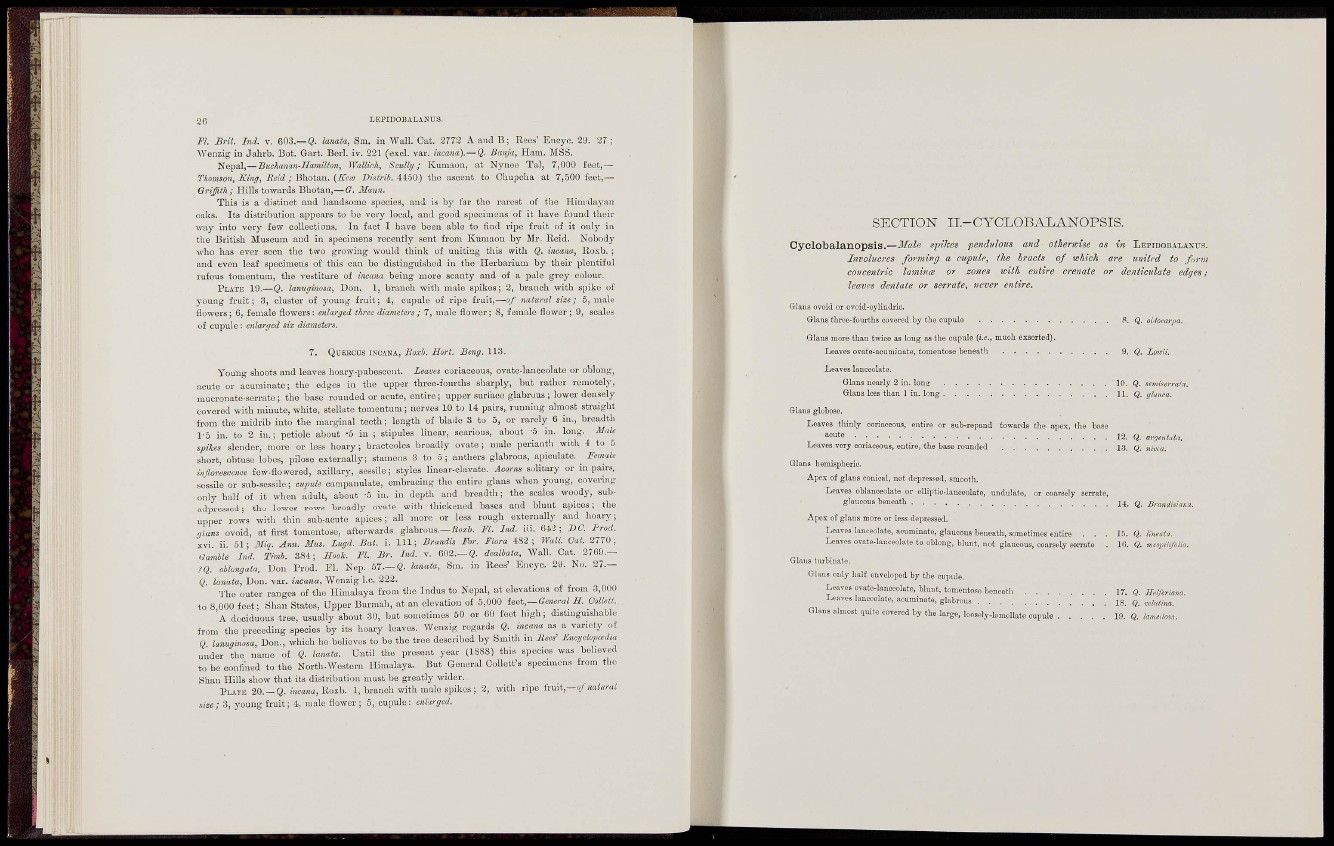
26 LEPIDOBALANUS.
Fl Brit. Intl. V. 603.—l a n a t a , Sm. in Wall. Cat. 2772 A and B; Rees' Encyo. 29. 37;
"\Yenzig iu Jahvb. Bot. Gart. Berl. iv. 221 (excl. var. inGana).—Q. Baiij'a, Ham. ilSS.
"iaQpal^Suckamn-EamiUon, WallicJi, SauUy; Kuoiaon, at Nynee Tal, 7,000 feet,—
Thomson, King, Reid ; Bhotan. {Kew Bistrib. 4450} the ascent to Chupcba at 7,500 feet,—
Qri^th; Hills towards Bhotan,—Í?. Mann.
This is a distinct and handsome species, and is by far the rarest of the Hiumlayan
oaks. Its distribution appears to be vety local, and good specimens of it have found their
way into very few collections. In fact I have been able to find ripe fruit of it only in
the British Museum and in specimens recently sent from Kumaon by Mr, Heid. Nobody
who has ever seen the two growing would think of uniting this with Q. incana, Roxb. ;
and even leaf specimens of this can be distinguished in the Herbarium by their plentiful
rufous totnentum, the vestitare of incana being more scanty and of a pale grey colour.
PLATE 19.—Q. lanuginosa^ Don. 1, branch with male spikes; 2, branch with spike of
young fruit; 3, cluster of young fruit; 4, cupule of ripe fruit,—of natural size; 5, male
flowers; 6, female flowers: enlarged three diameters ; 7, male flower; 8, female flower ; 9, scales
of cupule : enlarged six diameters.
7. QUEKCUS LIICANA, Boxl). Hort. Beng. 113.
Young shoots and leaves hoary-pubescent. Leaves coriaceous, ovate-lanceolate or oblong,
acute or acuminate; the edges in the upper three-fourths sharply, but rather rcmotel}-,
mucronate-serrate; the base rounded or acute, entire; upper surlace glabrous; lower densely
covered with minute, white, stellate tomentum; nerves 10 to 14 pairs, running almost straight
from the midrib into the marginal teeth; length of blade 3 to 5, or rarely 6 in., breadth
1-5 in. to 2 in.; petiole about -o in ; stipules linear, scarious, about -o in. long. Male
spikes slender, more or less hoary; bracteoles broadly ovate; male periantli with 4 to 5
short, obtuse lobes, pilose externally; stamens 3 to 5 ; anthers glabrous, apiculate. Female
inflorescence few-fiowered, axillary, sessile; styles linear-clavate. Acorns solitaxy or in pairs,
sessfle or sub-sessile; cupule campanulate, embracing the entire glans when young, covering
only half of it when adult, about 'O in. in depth and breadth; the scales woody, subadpressed;
the lower rows broadly ovate with thickened bases and blunt apices; the
upper rows with thin sub-acute apices; all more or less rough externally and hoary;
gtans ovoid, at fii-st tomentose, afterwards g l a b r o u s—F l . Ind. iU. Gi2 ; DC. Frod.
xvi ii. 51; Miq. Ann. Mus. Lugd. Bat. i. I l l ; Brandis For. Flora 482; Wall. Gat. 2770;
Gamhle Ind. Timh. 384; Sook. FL Br. Ind. v. m.-Q. dealbata, Wall. Cat. 2769—
?Q. olhngaia, Don Prod. Fl. Nep. 57—«. lanata, Sm. in Kees' Encyc. SiJ. No. 27 —
Q lunaia, Don. var. incana. Wenzig I.e. 222.
The outer ranges of the Himalaya from the Indus to Nepal, at elevations of from 3,000
to 8 000 feet; Shan States, Upper Burmah, at an elevation of 5,000 U&t,-General H. CoUett.
A deciduous tree, usually about 30, but sometimes 50 or 60 feet high; distmguishable
from the preceding species by its hoary leaves. Wenzig regards Q. incana as a variety of
Q lanuginosa Don., which he believes to be the tree described by Smith in liees Encyclopwdia
under the name of Q. lanala. Until the present year (1888) this species was behcved
to be confined to the North-Western Himalaya. Bat General Collett's specimens from the
Shan Hills show that its distribution must be greatly wider.
PLATE ^O. — Q. incana,'Roib. 1, branch with male spikes; 2, with ripe {rv:it,—of naiurul
sise; 3, young fruit; 4, male flower ; 5, cupule : enlarged.
SECTION II.-CYCLOBALANOPSIS.
Cyclobalanopsis.—i^íí/« spikes pendi/lozis and otherwise as in LEPTDOBALANUS.
Involucres forming a cupule, the bracts of which are united to farm
concentric lamina or zones with entire crenate or denticulate edges;
leaves dentate or serrate, never entire.
Glans ovoid or ovoid-cylindric.
Glaas three-fourths covered by the cupule 8. Q. oidoearpa.
Glans more than twice as long as the cupule (i.e., much esserted).
Leaves ovate-acumiaate, tomentose beneath 9. Q. Lowii.
Leaves lanceolate.
Glans nearly 2 in. long 10. Q. semmrra'a.
Glans losB tbon 1 in. long H. Q. gluuca.
Glans globose.
Leaves thinly coriaceous, entire or sub-repand towards the ape?c, »he base
Q. a>-!;e>,iata.
Leaves very coriaceous, entire, the base rounded 13. Q. nivia.
Glans hemispheric.
Apex of glans conical, not depressed, smooth.
Leaves oblanceolate or elliptio-lanceolate, undulate, or coarsely serrate,
glaucous beneath Brandisiana.
Apes of glacs more or less depressed.
Leaves lanceolate, acuminate, glaucous beneath, sometimes entire . . . 15. Q. lineota.
Leaves ovate-lance oíate to oblong, blunt, not glaucous, coarsely serrate . Ifi. Q. nmpUi/olia.
Glaris turbinate.
Glans only Iialf enveloped by the cupule.
Leaves ovate-lanceolate, blunt, tomentose beneath 17. Q. Holferiana
Leaves lanceolate, acuminate, glabrous 18. Q. velutina.
Glans almost quite covered by the large, loosely-Iomellate cupule 19. Q. lamedora.